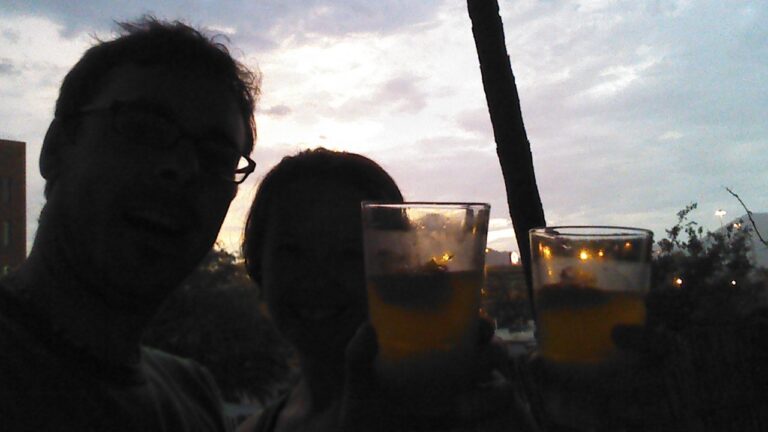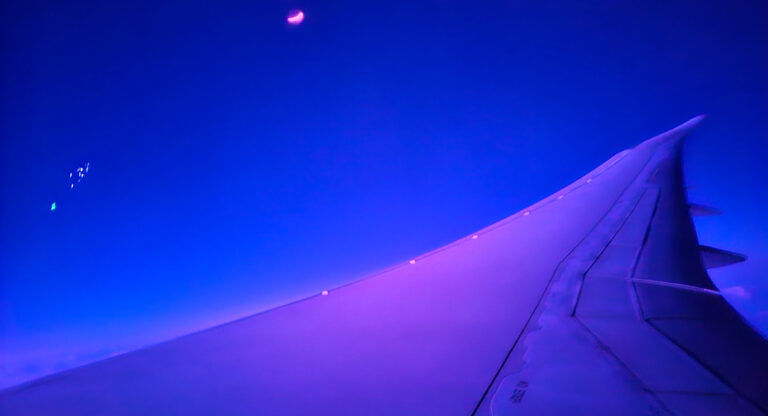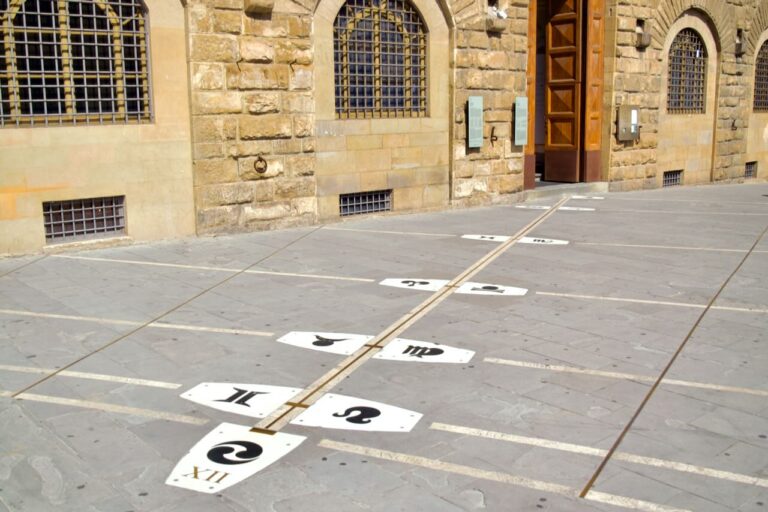Monday, September 2nd | 2024 | Day 5
Promptly at eight, the group piled onto a Eurovan for the first of many excursions to nearby sights throughout Tuscany. The van climbed into the hills southeast of Florence and stopped at a scenic overlook amidst large palazzos and villas that have been owned by noble families for generations. It was brief, so I only had time to take a couple mediocre shots through the shrubbery. In that first panoramic glimpse of the city from afar, I also took a moment to marvel at its beauty.
Once we reached the highway, the urban scene gave way to a more rural and agrarian lifestyle as we traveled through the countryside. Fields both fertile and fallow flashed by the window with each farmhouse, estate, and vineyard passed giving no more than a whisper of its history, perhaps centuries long. With roots potentially going back to the time of the Romans, or even the Etruscans, it was fascinating to contemplate how much this land had witnessed.
The van pulled into a Shell gas station where we grabbed a quick caffè and light breakfast. Before disembarking, Nadia explained how it all works.
Caffé culture in Italy is more dine and dash than a sit down, eggs and toast affair. Orders are taken and paid for at the register, then a ticket is handed to you. You give the ticket to the person making coffee and, in roughly the order received, your drink is placed on the counter–con amore. Even in non-roadside settings, many people stand at the bar, finish their espresso within a few minutes, and carry on about their day. In this particular instance, the only option was to stand at small circular tables around the posts supporting the ceiling. After another few minutes to finish my cornetto con pistacchio, we were back on the road.
A short while later, we arrived at San Gimignano. Our driver, Gianni, parked well outside the city, as no vehicular traffic is allowed within the medieval walls. Even if it had been, the narrow streets would have scarcely accommodated our beautiful silver beast of a chariot.
Stunning vistas of the rolling hills surrounding the city unfolded as we walked towards the main gate. Famed for towers built by medieval families intent on displaying their wealth and influence, out of seventy-two in total, only fourteen remain standing.
We wound our way through narrow alleys and dark tunnels in some of the older parts of town before arriving at the main square where we were joined by a local guide. She first showed us frescoes on the exterior walls of what used to be a palace for the ruling monarchs, while telling us about their history.
The next stop was Collegiata di Santa Maria Assunta. In contrast to the grand cathedrals built during the Gothic and Renaissance periods, Romanesque churches are quite plain from the outside. Don’t let that be reason to pass them by. Inside the Collegiata, the vault seemed to hold up the sky itself and naturally lifted one’s gaze toward heaven. Frescoes rendered in the 15th century stretched from floor to ceiling and wrapped around the entire nave. Most scenes were from the life of Christ, though a couple depicted local lore. The altar, apse and other areas of the basilica were exquisitely decorated.
One of the things about visiting timeless places of faith and worship is that they aren’t museums of past worlds displaying artifacts of a lost culture. For the most part, these sacred spaces remain lively centers at the heart of their communities—holding mass, baptisms, weddings, funerals, and other traditional rites.
Once the tour was over, the group was let loose for free time to shop and explore. My first gelato in Italy was with Maxine and Deborah at Gelateria Dondoli. Someone joked that the proprietor was better at marketing than making gelato. I would have to disagree! Lines can be notoriously long, but we got lucky that day, and within minutes had our frozen treats in hand. I went with Crema di Santa Fina, one of Sergio’s trademark flavors, in honor of the local saint we had just learned about. Niente altro che delizioso!
Shortly after dessert, it was time to make our way down the hill and back onto the van. While I don’t think I would have minded getting stranded in this picturesque hilltop village, I didn’t want to miss our next stop—lunch. And oh, what a treat we were in for after the short drive to Ristorante Albergaccio di Castellina.
At the top of a hill overlooking the valley below, in an unassuming stone building, this family restaurant served one of the best meals of the tour. And that’s saying something because, thanks to Nadia, we had a lot of fantastic meals. Everything was so fresh—starting with insalata, then prosciutto and melon. Secondi was made right in front of us during a short demo where potato, flour, and egg became gnocchi. Once rolled into its signature shape, it was brought to the kitchen before appearing on our plates minutes later, drizzled in a delightful red sauce with just a little kick of spice.
Next up was the small town Castellina in Chianti. With one main street and no crowds, it was a lovely respite from the bustle of Florence. The Chianti region is perhaps best known for its predominantly Sangiovese-based red varietal. Displayed on the side of a building on the central piazza, we learned that the black rooster can only be put on the label if the wine is authentic.
Also in the center of town was the Chiesa di San Salvatore. Built during the middle ages, it was reconstructed in neo-Romanesque style after being severely damaged during World War II. I of course had to check it out. Dedicated to San Fausto, the patron saint of Castellina, residents call upon him for protection from droughts, accidents, earthquakes, and epidemics. His earthly remains were on display in the right aisle in a gilded casket with a glass front. The saint’s skull was missing and had been replaced with one formed out of brown wax with his apparently real teeth inset. The same brown applique adorned the superbly long fingers. Some might consider it bizarre, but it was fascinating nonetheless.
After walking through a tunnel lined with a few shops and restaurants that once primarily functioned as a way to conceal troop movements from neighboring rivals, we again mounted our silver steed.
The van drove down back roads that were paved at first, then made an abrupt right onto a narrow dirt lane. So narrow that I wondered what would happen should we meet a vehicle coming the other way. Trees lining the route were somewhat overgrown given the height of the vehicle we were traveling in and the driver commented about it to Nadia. Maybe he was just complaining, but perhaps would be held responsible for any scratches or damage.
In the heart of Chianti, our destination was a vineyard built in 1750—Castello di Monsanto. First cultivated by the Palloni family of Florence, it is now owned by the Bianchis. As we emerged from the van, the first notable features were serenity and quiet. A gentle breeze flowed through an orderly row of cypress and our hostess, Laura, came to welcome us in.
We gathered in the foyer as she introduced herself and gave a short historical background of her family’s heritage. Cut into the tile floor, an octagonal portico of glass and steel revealed the underlying terrain. Curiously, the soil was crowded with large oyster shells. Noticing our interest, Laura explained that millions of years ago the land we now stood on was once a seabed. Fossils such as these were found everywhere they dug and provide essential minerals that give the wine distinct character. If a decade seems long, it’s hard to fathom a million years. Much less how many millions ago the Apennine spine of the Italian peninsula formed by seismic activity for many millions since, would have been underwater.
Continuing into the cellars provided a welcome reprieve from the heat with modern climate control maintaining constant temperature and humidity. Our hostess took us through dark, musty corridors lined with oak barrels filled with aging wine. Carved niches, some with roots extending through the stone, stored private collections lovingly prepared for their inheritors. Vintages dating back to 1961 when the vineyard was rediscovered and first plowed by Laura’s grandfather naturally included a fine Chianti from 1974.
The tour ended at an inconspicuous doorway leading to a flight of stairs that descended into the tasting room. It wasn’t quite a banquet hall, but could comfortably accommodate parties of a hundred or more. Plates of cheese and antipasto awaited along with carafes of water flavored with a variety of fresh fruit, if only to cleanse our palates between courses of wine. Laura poured four varietals, each made from a different blend of Sangiovese, Canaiolo, and other handpicked grapes. With my fiftieth trip around the sun a few months away, I asked for a price list.
Doors in the tasting room opened onto manicured grounds reminiscent of formal gardens found in France or England, though thoroughly devoid of pretense. Several patches of lily pads graced a pond with a single spouted fountain in the center, which provided just enough movement to what would have otherwise been silence. Four canopies invited guests to relax under their shade while savoring a glass and quiet repose amidst the scenery. There was only one table for six set up and I imagined the family gathering after the day’s work to enjoy time together while sipping the aged fruits of their time honored craft. After a few minutes to take some pictures, it was time to leave this charming estate.
Just before remounting our glorious silver steed, Laura handed me a price list. Only 350€ for a ’74 Chianti…I’m so worth it!
One of the many things I love about Italian culture is how connected they are to the land. To know the types of grasses grazed on by the sheep that are intrinsic to the distinct flavor of Pecorino Romano. To slow down and include time as a necessary ingredient and hallmark for high quality products. To the processes of curing, fermenting, and aging that produce some of the finest meat, wine, and cheese that have been cherished around the world for centuries. To tradition, history, faith, and a sense of place. To family, and to each other. Italy isn’t the only travel destination where these things can be found, but it is certainly a beautiful place to experience them all.


